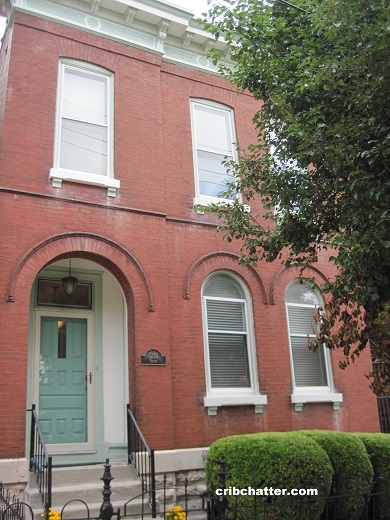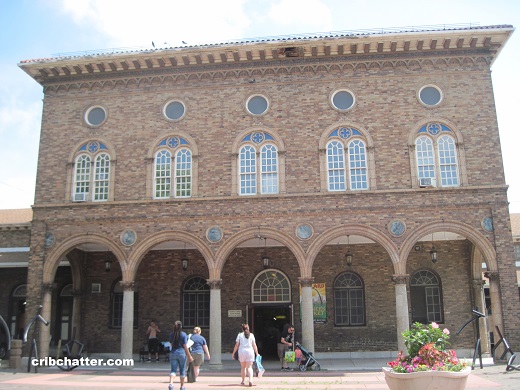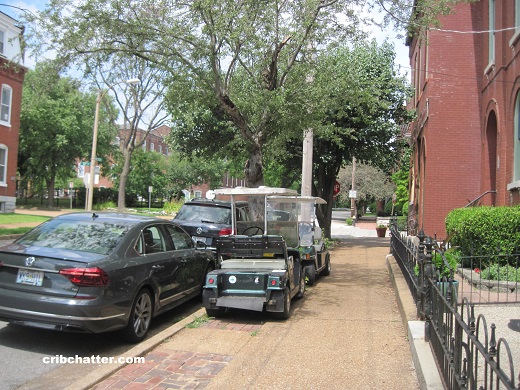St Louis Week: Get a Historic House in Soulard for Just $187,000: 1219 Victor
I recently spent some time in St. Louis.
St. Louis was the fourth largest city in America at one point (as was Charleston, South Carolina, incidentally.)
Much of its historic architecture remains.
Is St. Louis a buying opportunity for architecture lovers priced out of Washington DC, Boston, Chicago and Philadelphia?
I’ll be cribbing on St. Louis properties all week.
You might be surprised at what is going on there.
This 2-bedroom historic single family home at 1219 Victor in Soulard came on the market just 6 days ago and was under contract in 4 days.
Soulard is the oldest neighborhood in St. Louis and was originally founded by the French. Much of the homes are brick, with French-American style construction including iron balconies as you’d find in New Orleans.
The neighborhood preservation group became active in the 1980s and managed to save many of the structures. It is a city and National landmark district.
Soulard features the oldest farmers market west of the Mississippi River and the second largest Mardi Gras in America.
The Anheuser Busch brewery anchors the south end of the neighborhood.
It’s just about a mile and a half from downtown along the Mississippi River.
Built in 1891 on a 28×68 lot, the brick house has some of its historic features such as pocket doors and a refurbished cornice.
The house has just 1580 square feet and no garage or parking.
Street parking was plentiful when I was there on a Saturday.
Also, apparently many homeowners drive golf carts around the hilly neighborhood. I saw a half a dozen just parked outside homes and restaurants.
It has two fireplace mantles (they are non-functional) and high ceilings.
There’s a half bath on the main level and the full bath on the second floor.
The kitchen has what look like wood cabinets and stainless steel appliances.
The house has a full walk-out basement.
It has a double deck and a brick patio.
The house has central air, a must in hot and humid St. Louis.
Soulard is one of the hottest neighborhoods in the city. This was one of the few single family homes currently for sale in the neighborhood under $200,000.
If you love historic homes, is Soulard a hidden gem?
Mona Parsley at Re/Max Gold VI has the listing. See the pictures here.
1219 Victor: 2 bedrooms, 1.5 baths, 1580 square feet
- Originally listed in 2007 for $225,000
- Reduced many times
- Removed from the market in 2012at $185,000
- Currently listed at $187,400
- Under contract in 4 days
- Taxes of $3576
- Central Air
- No parking
- 2 fireplace mantles (non functional)
- Bedroom #1: 10×13 (second floor)
- Bedroom #2: 13×15 (second floor)
- Office/bonus room: 6×9



“Is St. Louis a buying opportunity for architecture lovers priced out of Washington DC, Boston, Chicago and Philadelphia?”
ehhhh thats gonna be a no from me dawg
personally I can’t stand St. Louis, no doubt there is some interesting architecture there for cheap but there is a reason it is so cheap and that is because very few want to live there. I think if you have a really long term perspective it might be a good investment opportunity though!
you can get the same thing in Chicago for the same price….unfortuantely it’ll be on the South and West sides. LoL
“as was Charleston, South Carolina”
In 1790. With a population of 16,359, about 1/8th its current population.
St Louis used to be a legitimately large city–in the top 10 largest from 1850 until 1960, peaking at 856k+ people. Drop from peak (as a %) is about the same as Detroit.
As to the property: how is the 2d floor 65 sf larger than the first? The 3d bedroom (office) is about 65 sf, and a bit of it is over the porch area, but not nearly all of it. Think this place is closer to 1400 than the claimed 1580.
Admit it, you’ve always wanted a balcony off your master bathroom!
Several years ago, I had a NYC-based client. The company was acquired by another firm that had most of its back office operational personnel in St Louis. After one meeting in STL, one of the top executives in New York simply refused to ever go to St Louis again. Just flat out would NOT go there.
“Admit it, you’ve always wanted a balcony off your master bathroom!”
I have one now, and can tell you that its pretty amazing
I like parts of St. Louis and Clayton – kind of like Chicago or Evanston, but hillier. But if you want a Victorian house in a river town, Louisville is also an option.
I guess somebody is on vacation in Stl this week?
“you can get the same thing in Chicago for the same price….unfortuantely it’ll be on the South and West sides. LoL”
Built in 1890? In a historic district?
Only in Pullman.
Many of the homes reminded me of Pullman, actually. But these are closer to the street in the Georgetown/Old Town Alexandria style.
“But if you want a Victorian house in a river town, Louisville is also an option.”
Are they brick there? Lots of French influence in Soulard, for obvious reasons. Since it was a French city, they mimicked those styles. Did they do so in Louisville?
“After one meeting in STL, one of the top executives in New York simply refused to ever go to St Louis again.”
The Four Seasons or the Ritz wasn’t good enough for them?
Give me a break.
Every city has great areas and not so great areas. If his “meeting” was in one of the suburbs, ala a St. Charles or Elgin type of location, would it be all that great? Nope.
I do have to say, St Louis is a little behind in having the cool boutique hotels. Two have recently opened in downtown in converted historic buildings but it could use a few more smaller, trendy, romantic hotels. There’s a plan to build one in Lafayette Square in a big development there which will also include apartments and retail.
“In 1790. With a population of 16,359, about 1/8th its current population.”
On the eve of the Revolutionary war, only NY, Boston and Philly were larger but Charleston was likely the richest due to its port.
Oh anon(tfo), maybe you should look up what the actual boundaries were for “Charleston” in the 1700s versus what it is now. Gosh. It might be a real eye opener. Actually tells you how dense it was.
While we’re talking about population and history, Charleston WAS the 4th largest city in the Colonies and dropped down to 22nd largest by the time of the civil war because traders stopped using their port due to their strict laws on slaves. The city was also burned down in the civil war and in 1886 suffered a nasty earthquake.
It only added population in the last century due to the massive expansion of its boundaries. And even then, like most urban areas, it was abandoned in the 50s through the 1980s until some preservationists stepped in to save buildings/neighborhoods in the 1990s much like they did in Chicago and St Louis (as well as other cities.)
Charleston was genius with its drive to be a tourist destination. Other cities can learn something from it. St Louis has just as many historic structures. Why isn’t it voted the #1 city in North America like Charleston which is much smaller in both size and population? Charleston put hotels in the center of its historic district. Ditto with New Orleans in the French Quarter. St Louis has not. There’s not a single hotel in Soulard, for instance.
“Oh anon(tfo), maybe you should look up what the actual boundaries were for “Charleston” in the 1700s”
Oh, gosh, Sabrina, are you suggesting that 18th c. towns were compact and denser than almost any modern city? Who knew!!
Louisville vs STL – Sabrina, yes, lots of brick. It’s known as having one of the biggest and best preserved Victorian neighborhoods in the country (probably less than the total of St. Louis, but a contiguous area). I think the brick is a result of the German influence in both cities – by the 19th Century they were both pretty German (but some French in Louisville). STL though, having better transport links (multiple intercity rail options vs none in Louisville) and local transit (light rail to airport from downtown and to Illinois side of river vs no local rail in Louisville) .
What I remember most from STL suburbs was mile after mile of the same brick on every kind of building and style of building. No variety.
“I think the brick is a result of the German influence in both cities – by the 19th Century they were both pretty German”
I see there’s a Germantown in Louisville.
It’s bigger than I thought (population-wise) but much smaller than St. Louis in the metro area.
I may have to go to visit that Victorian neighborhood. Thanks for the info.
“Oh, gosh, Sabrina, are you suggesting that 18th c. towns were compact and denser than almost any modern city?”
Um…no. If you knew anything about Charleston or had bothered to look it up (which you did not, instead you just attacked, attacked, attacked as usual) you would realize that the Charleston of 1790 was at the tip of the peninsula on just 80 acres set up in a grid of 8 blocks. Literally, what is now part of the historic district.
In the last 30 years, it has gone from 18 square miles to over 100 square miles thanks to annexation. Hence, the big gains in its population since 1790.
I was suggesting that there was no real comparison, as a “4th largest city”, between a town of 20,000 (regardless of acreage), which only surpassed 100,000 in the last 20 years, and a city of over half a million.
Salem, MA, was one of the 10 largest cities in the US in the first 4 censuses, too. Basically the same %age of NY’s population in 1790 as Houston is today. It’s historical trivia.
“It’s historical trivia.”
It’s actually not because there were cities like Baltimore which should have been larger than Charleston.
Much like St. Louis (also the 4th largest at one point, which was my point) it lost its status through a combination of factors including its harsh treatment of slaves and changes in shipping. By the time of the Civil War, it had dropped to 22nd largest. A shocking decline in its fortunes.
The burning of the city in the war only added to its problems. The earthquake didn’t help either.
I would imagine that Cincinnati is also similar though I’m less familiar with it than Louisville and STL. I gather it has a lot of historic neighborhoods and I think a livelier downtown than either of the other two.
“cities like Baltimore which should have been larger than Charleston”
B’more was larger by 1800. 40% larger, and #3 ahead of Boston.
Why “should” Baltimore have been larger in 1790? Fells Point was still a separate town then!
“I would imagine that Cincinnati is also similar though I’m less familiar with it than Louisville and STL.”
Cincinnati had the horrible Over the Rhine neighborhood with drug dealers/crime. But they’ve really tried to save that and have put a lot of money into it. It’s great. Preservationists have converted the old warehouses into lofts. Now, a 1-bedroom there can go for $300,000 which isn’t any different than Chicago.